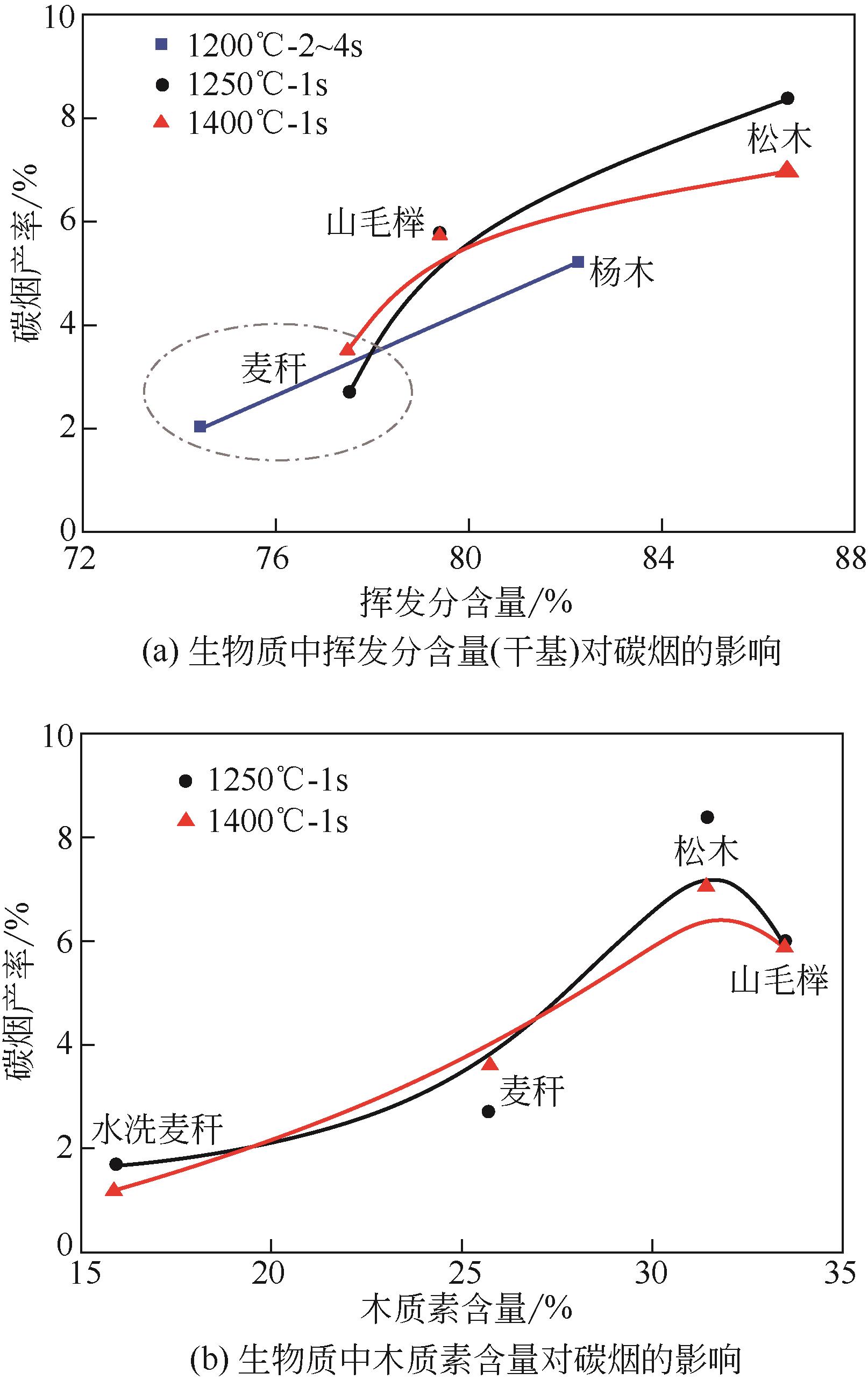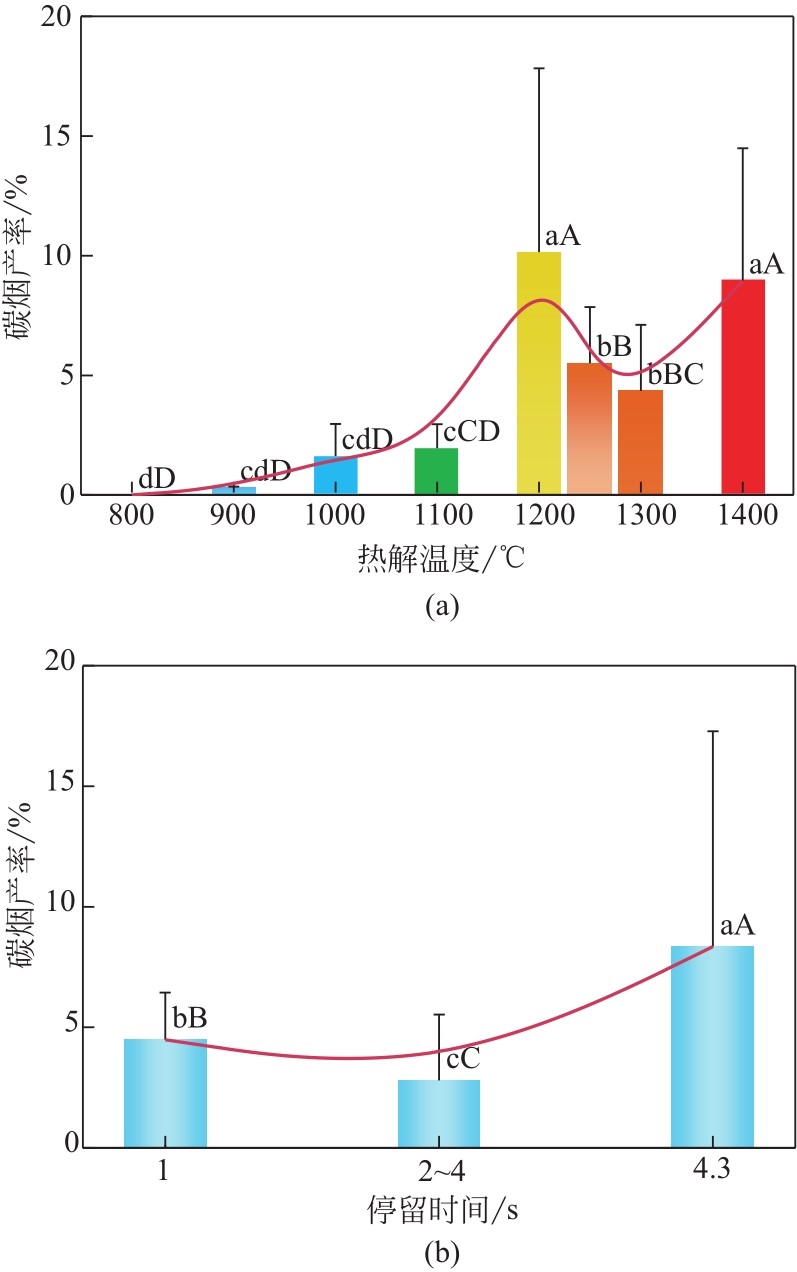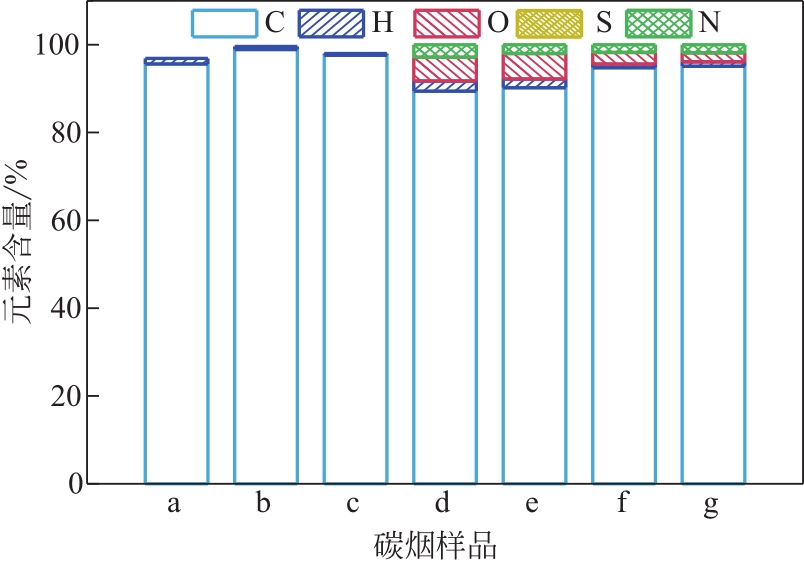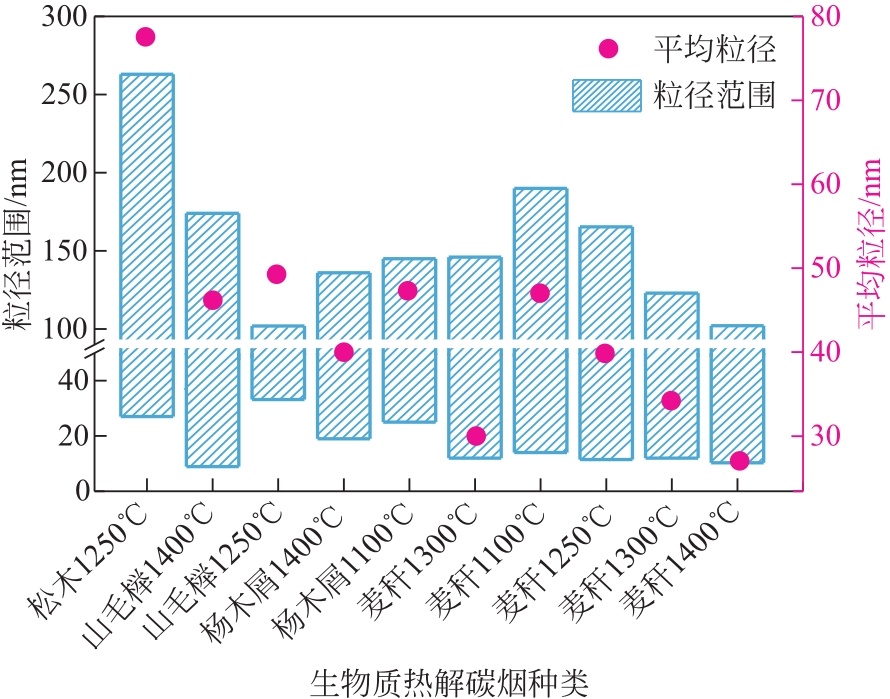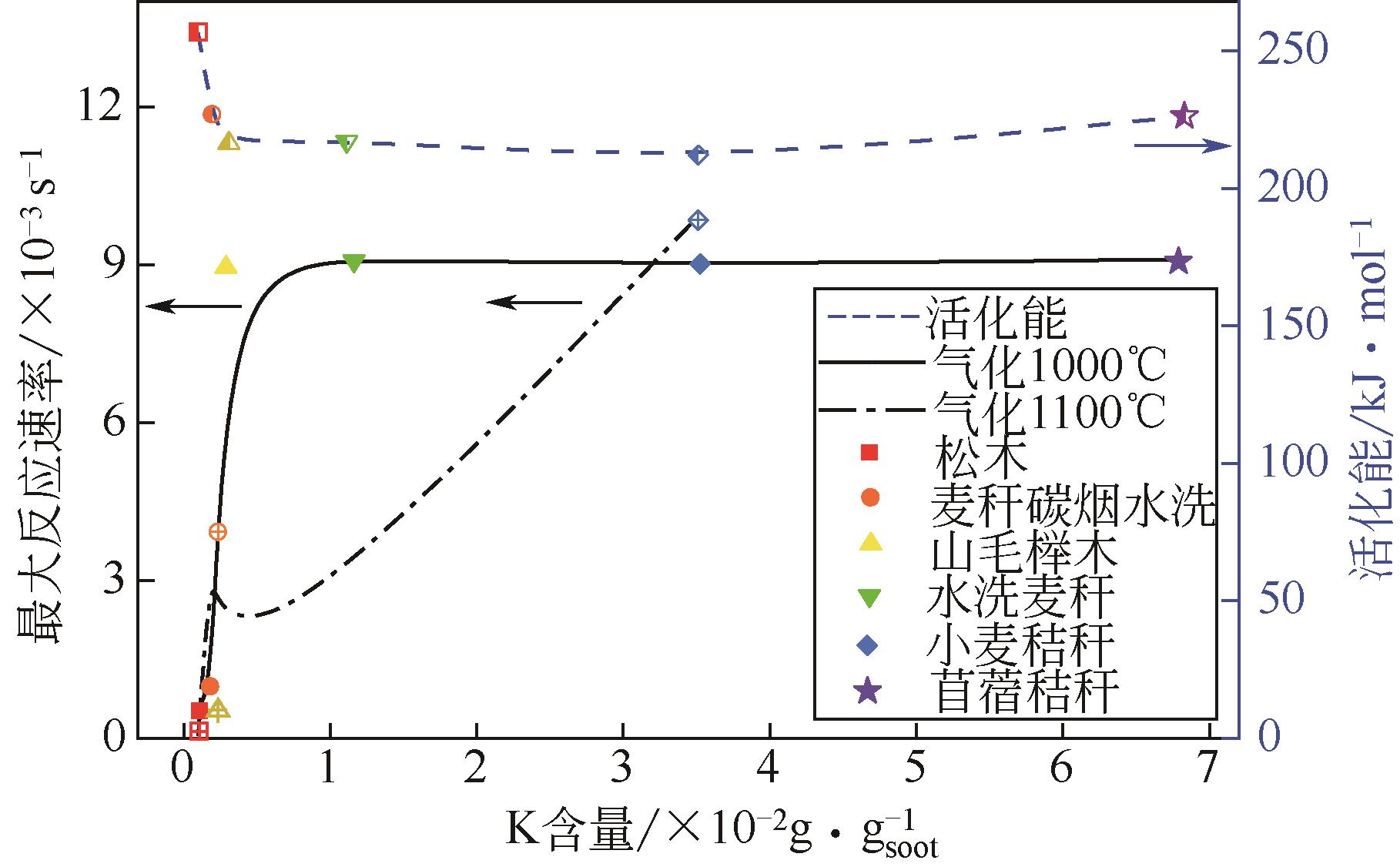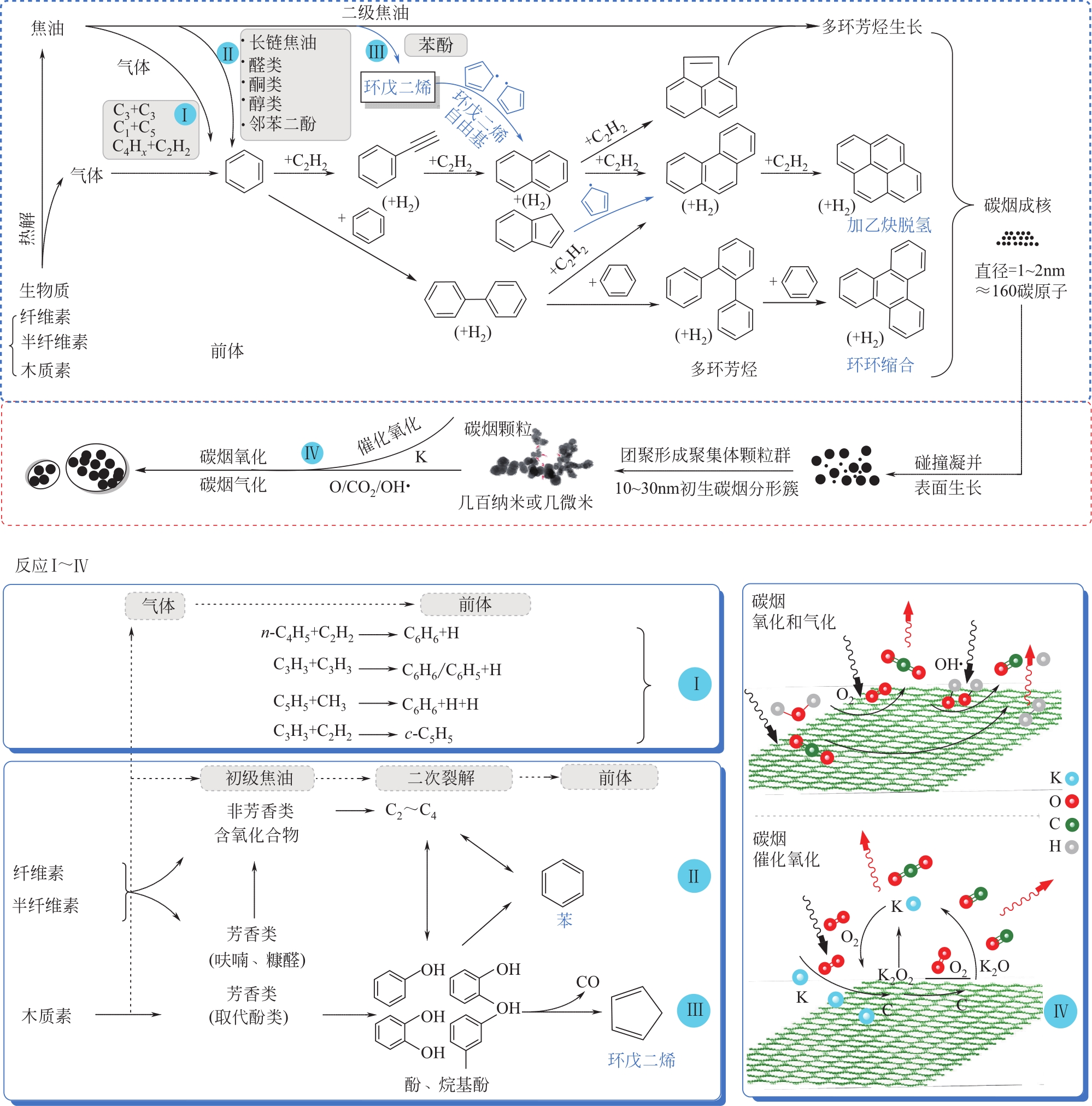Chemical Industry and Engineering Progress ›› 2021, Vol. 40 ›› Issue (10): 5772-5785.DOI: 10.16085/j.issn.1000-6613.2020-2208
• Resources and environmental engineering • Previous Articles Next Articles
Review on soot formation during biomass pyrolysis
JIANG Hao1( ), ZHU Youjian1,2(
), ZHU Youjian1,2( ), SHAO Jing’ai1,3, CHENG Wei1, WU Guihao1, YANG Haiping1, CHEN Hanping1,3
), SHAO Jing’ai1,3, CHENG Wei1, WU Guihao1, YANG Haiping1, CHEN Hanping1,3
- 1.State Key Laboratory of Coal Combustion, School of Energy and Power Engineering, Huazhong University of Science & Technology, Wuhan 430074, Hubei, China
2.School of Energy and Power Engineering, Zhengzhou University of Light Industry, Zhengzhou 450002, Henan, China
3.Department of New Energy Science and Engineering, School of Energy and Power Engineering, Huazhong University of Science & Technology, Wuhan 430074, Hubei, China
-
Received:2020-11-05Revised:2020-12-22Online:2021-10-25Published:2021-10-10 -
Contact:ZHU Youjian
生物质热解碳烟的研究进展
蒋好1( ), 朱有健1,2(
), 朱有健1,2( ), 邵敬爱1,3, 成伟1, 吴贵豪1, 杨海平1, 陈汉平1,3
), 邵敬爱1,3, 成伟1, 吴贵豪1, 杨海平1, 陈汉平1,3
- 1.华中科技大学能源与动力工程学院煤燃烧国家重点实验室,湖北 武汉 430074
2.郑州轻工业大学能源与动力工程学院,河南 郑州 450002
3.华中科技大学能源与动力工程学院新能源科学与工程系,湖北 武汉 430074
-
通讯作者:朱有健 -
作者简介:蒋好(1994—),男,硕士研究生,研究方向为生物质和含碳固废热解。E-mail:jiang_hao@hust.edu.cn 。 -
基金资助:国家自然科学基金(51706210)
CLC Number:
Cite this article
JIANG Hao, ZHU Youjian, SHAO Jing’ai, CHENG Wei, WU Guihao, YANG Haiping, CHEN Hanping. Review on soot formation during biomass pyrolysis[J]. Chemical Industry and Engineering Progress, 2021, 40(10): 5772-5785.
蒋好, 朱有健, 邵敬爱, 成伟, 吴贵豪, 杨海平, 陈汉平. 生物质热解碳烟的研究进展[J]. 化工进展, 2021, 40(10): 5772-5785.
share this article
Add to citation manager EndNote|Ris|BibTeX
URL: https://hgjz.cip.com.cn/EN/10.16085/j.issn.1000-6613.2020-2208
| 取样装置 | 取样原理 | 浓度监测 | 粒径监测 | 实时 | 优点 | 缺点 |
|---|---|---|---|---|---|---|
| 夹套式过滤器[ | 滤膜截留采样 | 重量法计算 质量浓度 | 显微镜与图像软件估计 | 否 | 取样简单,样品可进行化学分析 | 称重受天平精度影响,显微镜图像识别粒径代表性不够强 |
| 激光粒度仪(光衍射法)测量体积粒径分布 | 否 | 自动化程度高, 测试范围广 | ||||
| 低压冲击器(LPI)[ | 冲击法采样 | 重量法计算 质量浓度 | 级联冲击法对粒径分级(30~10000nm) | 否 | 按粒径分级取样,尺寸范围大 | 称重受天平精度影响,极小颗粒不易分级,收集样品有限 |
| 稀释取样-粒子迁移率光谱仪分析系统 [ | 利用微孔探针稀释采样连接光学仪器分析 | 冷凝计数器 检测数量浓度 | 差分迁移率筛分仪分析粒径(3~1000nm) | 是 | 实时测量,适用小颗粒 | 不能直接收集样品进行分析 |
| 取样装置 | 取样原理 | 浓度监测 | 粒径监测 | 实时 | 优点 | 缺点 |
|---|---|---|---|---|---|---|
| 夹套式过滤器[ | 滤膜截留采样 | 重量法计算 质量浓度 | 显微镜与图像软件估计 | 否 | 取样简单,样品可进行化学分析 | 称重受天平精度影响,显微镜图像识别粒径代表性不够强 |
| 激光粒度仪(光衍射法)测量体积粒径分布 | 否 | 自动化程度高, 测试范围广 | ||||
| 低压冲击器(LPI)[ | 冲击法采样 | 重量法计算 质量浓度 | 级联冲击法对粒径分级(30~10000nm) | 否 | 按粒径分级取样,尺寸范围大 | 称重受天平精度影响,极小颗粒不易分级,收集样品有限 |
| 稀释取样-粒子迁移率光谱仪分析系统 [ | 利用微孔探针稀释采样连接光学仪器分析 | 冷凝计数器 检测数量浓度 | 差分迁移率筛分仪分析粒径(3~1000nm) | 是 | 实时测量,适用小颗粒 | 不能直接收集样品进行分析 |
| 原料 | 热解温度/℃ | 反应器 | 停留时间/s | 碳烟产率/% |
|---|---|---|---|---|
| 松木[ | 1000/1250/1400 | 滴管炉 | 1① | 3.3/8.36/6.97 |
| 山毛榉[ | 1000/1250/1400 | 滴管炉 | 1① | 3.0/5.89/5.81 |
| 山毛榉[ | 800/1000/1200/1400 | 滴管炉 | 4.3 | 0/0/17/16.8 |
| 山毛榉[ | 800/1000/1200/1400 | 滴管炉 | 4.3 | 0/0/16.4/16.6 |
| 山毛榉[ | 1400 | 滴管炉 | 2.6 | 8.55 |
| 木屑[ | 800/1000/1200 | 滴管炉 | — | 0.1/0.5/2.7 |
| 杨木屑[ | 900/1000/1100/1200/1300 | 滴管炉 | 2~4 | 0.3/1.3/2.7/5.2/6.3 |
| 木屑[ | 1100/1250 | 固定床 | 2 | 4.52/7.39 |
| 麦秸[ | 1000/1250/1400 | 滴管炉 | 1① | 2.0/2.66/3.53 |
| 麦秆[ | 1000/1200 | 滴管炉 | — | 0.2/2.2 |
| 稻秆[ | 1000/1200 | 滴管炉 | — | 0.2/2.25 |
| 麦秆[ | 900/1000/1100/1200/1300 | 滴管炉 | 2~4 | 0.3/0.5/1.3/2.0/2.4 |
| 麦秆[ | 900~1200 | 固定床 | 0.2 | 无碳烟生成 |
| 麦秆[ | 1000/1100/1200/1250 | 固定床 | 2 | 0.47/3.34/5.95/6.21 |
| 水洗麦秆[ | 1000/1100/1200 | 固定床 | 2 | 0.37/3.78/6.23 |
| 苜蓿秸秆[ | 1000/1250/1400 | 滴管炉 | 1① | 2.8/5.1/4.4 |
| 纤维素[ | 1250 | 滴管炉 | 1① | <1 |
| 半纤维素[ | 1250 | 滴管炉 | 1① | <1 |
| 麦秆提取木质素[ | 1250 | 滴管炉 | 1① | 13 |
| 软木提取木质素[ | 1250 | 滴管炉 | 1① | 9.8 |
| 纤维素[ | 1300 | 滴管炉 | 1.3 | 1.16 |
| 木聚糖[ | 1300 | 滴管炉 | 1.3 | 0.7 |
| 木质素[ | 1300 | 滴管炉 | 1.3 | 10.07 |
| 原料 | 热解温度/℃ | 反应器 | 停留时间/s | 碳烟产率/% |
|---|---|---|---|---|
| 松木[ | 1000/1250/1400 | 滴管炉 | 1① | 3.3/8.36/6.97 |
| 山毛榉[ | 1000/1250/1400 | 滴管炉 | 1① | 3.0/5.89/5.81 |
| 山毛榉[ | 800/1000/1200/1400 | 滴管炉 | 4.3 | 0/0/17/16.8 |
| 山毛榉[ | 800/1000/1200/1400 | 滴管炉 | 4.3 | 0/0/16.4/16.6 |
| 山毛榉[ | 1400 | 滴管炉 | 2.6 | 8.55 |
| 木屑[ | 800/1000/1200 | 滴管炉 | — | 0.1/0.5/2.7 |
| 杨木屑[ | 900/1000/1100/1200/1300 | 滴管炉 | 2~4 | 0.3/1.3/2.7/5.2/6.3 |
| 木屑[ | 1100/1250 | 固定床 | 2 | 4.52/7.39 |
| 麦秸[ | 1000/1250/1400 | 滴管炉 | 1① | 2.0/2.66/3.53 |
| 麦秆[ | 1000/1200 | 滴管炉 | — | 0.2/2.2 |
| 稻秆[ | 1000/1200 | 滴管炉 | — | 0.2/2.25 |
| 麦秆[ | 900/1000/1100/1200/1300 | 滴管炉 | 2~4 | 0.3/0.5/1.3/2.0/2.4 |
| 麦秆[ | 900~1200 | 固定床 | 0.2 | 无碳烟生成 |
| 麦秆[ | 1000/1100/1200/1250 | 固定床 | 2 | 0.47/3.34/5.95/6.21 |
| 水洗麦秆[ | 1000/1100/1200 | 固定床 | 2 | 0.37/3.78/6.23 |
| 苜蓿秸秆[ | 1000/1250/1400 | 滴管炉 | 1① | 2.8/5.1/4.4 |
| 纤维素[ | 1250 | 滴管炉 | 1① | <1 |
| 半纤维素[ | 1250 | 滴管炉 | 1① | <1 |
| 麦秆提取木质素[ | 1250 | 滴管炉 | 1① | 13 |
| 软木提取木质素[ | 1250 | 滴管炉 | 1① | 9.8 |
| 纤维素[ | 1300 | 滴管炉 | 1.3 | 1.16 |
| 木聚糖[ | 1300 | 滴管炉 | 1.3 | 0.7 |
| 木质素[ | 1300 | 滴管炉 | 1.3 | 10.07 |
| 源 | Ⅲ类平方和 | 自由度 | 均方 | F | 显著性 |
|---|---|---|---|---|---|
| 修正模型 | 804.200 | 14 | 57.443 | 56.774 | 0.000 |
| 截距 | 505.266 | 1 | 505.266 | 499.386 | 0.000 |
| 原料类型 | 22.117 | 1 | 22.117 | 21.860 | 0.000 |
| 停留时间 | 104.945 | 2 | 52.473 | 51.862 | 0.000 |
| 热解温度 | 488.875 | 7 | 69.839 | 69.026 | 0.000 |
| 原料类型 * 停留时间 | 0.087 | 1 | 0.087 | 0.086 | 0.773 |
| 停留时间 * 热解温度 | 187.697 | 3 | 62.566 | 61.838 | 0.000 |
| 误差 | 16.188 | 16 | 1.012 | ||
| 总计 | 1559.937 | 31 | |||
| 修正后总计 | 820.388 | 30 |
| 源 | Ⅲ类平方和 | 自由度 | 均方 | F | 显著性 |
|---|---|---|---|---|---|
| 修正模型 | 804.200 | 14 | 57.443 | 56.774 | 0.000 |
| 截距 | 505.266 | 1 | 505.266 | 499.386 | 0.000 |
| 原料类型 | 22.117 | 1 | 22.117 | 21.860 | 0.000 |
| 停留时间 | 104.945 | 2 | 52.473 | 51.862 | 0.000 |
| 热解温度 | 488.875 | 7 | 69.839 | 69.026 | 0.000 |
| 原料类型 * 停留时间 | 0.087 | 1 | 0.087 | 0.086 | 0.773 |
| 停留时间 * 热解温度 | 187.697 | 3 | 62.566 | 61.838 | 0.000 |
| 误差 | 16.188 | 16 | 1.012 | ||
| 总计 | 1559.937 | 31 | |||
| 修正后总计 | 820.388 | 30 |
| 原料 | 热解温度 /℃ | 无机物种总质量分数 /% | 各元素质量分数/% | |||||
|---|---|---|---|---|---|---|---|---|
| Na | K | Cl | S | Si | Ca | |||
| 松木[ | 1250 | 0 | — | — | — | — | — | — |
| 1300 | 约0.2 | 0.075 | 0.1 | 0.037 | — | — | — | |
| 1400 | 0 | — | — | — | — | — | — | |
| 山毛榉[ | 1250 | 0.51 | — | 约0.3 | — | — | — | — |
| 1400 | 1.2 | — | — | — | — | — | — | |
| 麦秆[ | 1250 | 2.26 | — | — | — | — | — | — |
| 1400 | 12.18 | 0.47 | 1.6 | 0.53 | 0.8 | 1.11 | 0.28 | |
| 苜蓿秆[ | 1250 | 17 | — | — | — | — | — | — |
| 1400 | 21 | 0.7 | 7 | 4 | 0.8 | 0.36 | 0.57 | |
| 纤维素[ | 1300 | <0.43 | — | — | — | — | — | — |
| 木聚糖[ | 1300 | 1.55 | 0.97 | 0.24 | 0.07 | 0.27 | — | — |
| 木质素[ | 1300 | 0.43 | 0.22 | 0.15 | 0.03 | 0.02 | — | — |
| 原料 | 热解温度 /℃ | 无机物种总质量分数 /% | 各元素质量分数/% | |||||
|---|---|---|---|---|---|---|---|---|
| Na | K | Cl | S | Si | Ca | |||
| 松木[ | 1250 | 0 | — | — | — | — | — | — |
| 1300 | 约0.2 | 0.075 | 0.1 | 0.037 | — | — | — | |
| 1400 | 0 | — | — | — | — | — | — | |
| 山毛榉[ | 1250 | 0.51 | — | 约0.3 | — | — | — | — |
| 1400 | 1.2 | — | — | — | — | — | — | |
| 麦秆[ | 1250 | 2.26 | — | — | — | — | — | — |
| 1400 | 12.18 | 0.47 | 1.6 | 0.53 | 0.8 | 1.11 | 0.28 | |
| 苜蓿秆[ | 1250 | 17 | — | — | — | — | — | — |
| 1400 | 21 | 0.7 | 7 | 4 | 0.8 | 0.36 | 0.57 | |
| 纤维素[ | 1300 | <0.43 | — | — | — | — | — | — |
| 木聚糖[ | 1300 | 1.55 | 0.97 | 0.24 | 0.07 | 0.27 | — | — |
| 木质素[ | 1300 | 0.43 | 0.22 | 0.15 | 0.03 | 0.02 | — | — |
| 1 | GOYAL H B, SEAL D, SAXENA R C. Bio-fuels from thermochemical conversion of renewable resources: a review[J]. Renewable and Sustainable Energy Reviews, 2008, 12(2): 504-517. |
| 2 | CHEN X, CHE Q F, LI S J, et al. Recent developments in lignocellulosic biomass catalytic fast pyrolysis: strategies for the optimization of bio-oil quality and yield[J]. Fuel Processing Technology, 2019, 196: 106180. |
| 3 | 仉利, 姚宗路, 赵立欣, 等. 生物质热化学转化提质及其催化剂研究进展[J]. 化工学报, 2020, 71(8): 3416-3427. |
| ZHANG Li, YAO Zonglu, ZHAO Lixin, et al. Research progress on thermochemical conversion of biomass to enhance quality and catalyst[J]. CIESC Journal, 2020, 71(8): 3416-3427. | |
| 4 | 罗俊, 邵敬爱, 杨海平, 等. 生物质催化热解制备低碳烯烃的研究进展[J]. 化工进展, 2017, 36(5): 1555-1564. |
| LUO Jun, SHAO Jing'ai, YANG Haiping, et al. Research progresses on production of light olefins from catalytic pyrolysis of biomass[J]. Chemical Industry and Engineering Progress, 2017, 36(5): 1555-1564. | |
| 5 | 何文修, 张智亮, 计建炳. 稻壳生物质资源利用技术研究进展[J]. 化工进展, 2016, 35(5): 1366-1376. |
| HE Wenxiu, ZHANG Zhiliang, JI Jianbing. Research progress of rice husk utilization technologies[J]. Chemical Industry and Engineering Progress, 2016, 35(5): 1366-1376. | |
| 6 | QIN K, LIN W G, FÆSTER S, et al. Characterization of residual particulates from biomass entrained flow gasification[J]. Energy & Fuels, 2013, 27(1): 262-270. |
| 7 | 熊刚. 煤和生物质燃烧碳烟生成的实验研究[D]. 北京: 清华大学, 2011. |
| XIONG Gang. Experimental study of soot formation during the combustion of coal and biomass[D]. Beijing: Tsinghua University, 2011. | |
| 8 | 刘丽, 郭瑞英, 沈振兴, 等. 西安冬、夏季大气PM10化学组成的昼夜污染特征[J]. 地球环境学报, 2012, 3(5): 1053-1059. |
| LIU Li, GUO Ruiying, SHEN Zhenxing, et al. Day-night pollution characteristics of PM10 during winter and spring over Xi'an[J]. Journal of Earth Environment, 2012, 3(5): 1053-1059. | |
| 9 | KIM K H, KABIR E, KABIR S. A review on the human health impact of airborne particulate matter[J]. Environment International, 2015, 74: 136-143. |
| 10 | CHO S H, YOO J I, TURLEY A T, et al. Relationships between composition and pulmonary toxicity of prototype particles from coal combustion and pyrolysis[J]. Proceedings of the Combustion Institute, 2009, 32(2): 2717-2725. |
| 11 | 管诗骈, 高翔, 谭永杰, 等. 燃烧过程中碳黑颗粒生成机理的研究进展[J]. 能源工程, 2003(3): 31-34. |
| GUAN Shipian, GAO Xiang, TAN Yongjie, et al. Research development on the mechanism of soot formation in combustion[J]. Energy Engineering, 2003(3): 31-34. | |
| 12 | RAMANATHAN V, CARMICHAEL G. Global and regional climate changes due to black carbon[J]. Nature Geoscience, 2008, 1(4): 221-227. |
| 13 | BOND T C, DOHERTY S J, FAHEY D W, et al. Bounding the role of black carbon in the climate system: a scientific assessment[J]. Journal of Geophysical Research: Atmospheres, 2013, 118(11): 5380-5552. |
| 14 | AMARAL S, DE CARVALHO J, COSTA M, et al. An overview of particulate matter measurement instruments[J]. Atmosphere, 2015, 6(9): 1327-1345. |
| 15 | TRUBETSKAYA A, JENSEN P A, JENSEN A D, et al. Effects of several types of biomass fuels on the yield, nanostructure and reactivity of soot from fast pyrolysis at high temperatures[J]. Applied Energy, 2016, 171: 468-482. |
| 16 | WANG X B, MA D Y, JIN Q M, et al. Synergistic effects of biomass and polyurethane co-pyrolysis on the yield, reactivity, and heating value of biochar at high temperatures[J]. Fuel Processing Technology, 2019, 194: 106127. |
| 17 | SEPTIEN S, VALIN S, DUPONT C, et al. Effect of particle size and temperature on woody biomass fast pyrolysis at high temperature (1000—1400℃)[J]. Fuel, 2012, 97: 202-210. |
| 18 | DENG C Y, LIAW S B, GAO X P, et al. Differences in soot produced from rapid pyrolysis of xylan, cellulose and lignin under pulverized-fuel conditions[J]. Fuel, 2020, 265: 116991. |
| 19 | DENG Changya, LIAW Sui Boon, WU Hongwei. Characterization of size-segregated soot from pine wood pyrolysis in a drop tube furnace at 1300℃[J]. Energy & Fuels, 2019, 33(3): 2293-2300. |
| 20 | MALIK A, NILSSON P T, PAGELS J. Methodology for sampling and characterizing internally mixed soot-tar particles suspended in the product gas from biomass gasification processes [J]. Energy & Fuels, 2011, 25(4): 1751-1758. |
| 21 | TRUBETSKAYA A, JENSEN P A, JENSEN A D, et al. Effect of fast pyrolysis conditions on biomass solid residues at high temperatures[J]. Fuel Processing Technology, 2016, 143: 118-129. |
| 22 | QIN K, JENSEN P A, LIN W G, et al. Biomass gasification behavior in an entrained flow reactor: gas product distribution and soot formation[J]. Energy & Fuels, 2012, 26(9): 5992-6002. |
| 23 | CHANG Q H, GAO R, LI H J, et al. Understanding of formation mechanisms of fine particles formed during rapid pyrolysis of biomass[J]. Fuel, 2018, 216: 538-547. |
| 24 | 李艳, 谭厚章, 王学斌, 等. 生物质高温热解气、液、固三相产物及碳烟生成特性[J]. 西安交通大学学报, 2018, 52(1): 61-68. |
| LI Yan, TAN Houzhang, WANG Xuebin, et al. Formation mechanisms of three-phase products and soot during the pyrolysis of biomass at high temperatures[J]. Journal of Xi'an Jiaotong University, 2018, 52(1): 61-68. | |
| 25 | WANG X B, JIN Q M, WANG L, et al. Synergistic effect of biomass and polyurethane waste co-pyrolysis on soot formation at high temperatures[J]. Journal of Environmental Management, 2019, 239: 306-315. |
| 26 | 李帅帅, 王学斌, 白胜杰, 等. 挥发分停留时间、温度和水洗对生物质热解生成碳烟的影响[J]. 燃烧科学与技术, 2019, 25(2): 131-138. |
| LI Shuaishuai, WANG Xuebin, BAI Shengjie, et al. Soot formation during biomass pyrolysis: effects of residence time, temperature and water-leaching[J]. Journal of Combustion Science and Technology, 2019, 25(2): 131-138. | |
| 27 | WANG X B, BAI S J, JIN Q M, et al. Soot formation during biomass pyrolysis: effects of temperature, water-leaching, and gas-phase residence time[J]. Journal of Analytical and Applied Pyrolysis, 2018, 134: 484-494. |
| 28 | TRUBETSKAYA A, BROWN A, TOMPSETT G A, et al. Characterization and reactivity of soot from fast pyrolysis of lignocellulosic compounds and monolignols[J]. Applied Energy, 2018, 212: 1489-1500. |
| 29 | GAI Zhike, ZHANG Rong, BI Jicheng. Characteristics of soot from rapid pyrolysis of coal and petroleum coke[J]. Energy & Fuels, 2017, 31(4): 3759-3767. |
| 30 | HAC KO J, WANG J C, XU Q Y. Characterization of particulate matter formed during sewage sludge pyrolysis[J]. Fuel, 2018, 224: 210-218. |
| 31 | LI Y, TAN H Z, WANG X B, et al. Characteristics and mechanism of soot formation during the fast pyrolysis of biomass in an entrained flow reactor[J]. Energy & Fuels, 2018, 32(11): 11477-11488. |
| 32 | WANG X B, LI Y, BAI S J, et al. Nano-scale soot particle formation during the high-temperature pyrolysis of waste plastics in an entrained flow reactor[J]. Waste and Biomass Valorization, 2019, 10(12): 3857-3866. |
| 33 | SEPTIEN S, VALIN S, PEYROT M, et al. Characterization of char and soot from millimetric wood particles pyrolysis in a drop tube reactor between 800℃ and 1400℃[J]. Fuel, 2014, 121: 216-224. |
| 34 | TRUBETSKAYA A, LARSEN F H, SHCHUKAREV A, et al. Potassium and soot interaction in fast biomass pyrolysis at high temperatures[J]. Fuel, 2018, 225: 89-94. |
| 35 | WIINIKKA H, WEILAND F, PETTERSSON E, et al. Characterisation of submicron particles produced during oxygen blown entrained flow gasification of biomass[J]. Combustion and Flame, 2014, 161(7): 1923-1934. |
| 36 | 李艳, 谭厚章, 刘原一, 等. 热解温度与碱金属对生物质热解碳烟氧化活性的影响[J]. 西安交通大学学报, 2020, 54(8): 20-26, 49. |
| LI Yan, TAN Houzhang, LIU Yuanyi, et al. Influences of formation temperature and potassium salts on oxidation reactivity of soot from biomass pyrolysis[J]. Journal of Xi'an Jiaotong University, 2020, 54(8): 20-26, 49. | |
| 37 | WANG X B, LI S S, ADEOSUN A, et al. Effect of potassium-doping and oxygen concentration on soot oxidation in O2/CO2 atmosphere: a kinetics study by thermogravimetric analysis[J]. Energy Conversion and Management, 2017, 149: 686-697. |
| 38 | LI Y, WANG X B, TAN H Z, et al. Evolution of PM2.5 from biomass high-temperature pyrolysis in an entrained flow reactor[J]. Journal of the Energy Institute, 2019, 92(5): 1548-1556. |
| 39 | LIU D, WANG W, YING Y Y, et al. Nanostructure and reactivity of carbon particles from co-pyrolysis of biodiesel surrogate methyl octanoate blended with n-butanol[J]. Fullerenes, Nanotubes and Carbon Nanostructures, 2018, 26(5): 278-290. |
| 40 | 周慧龙, 肖刚, 吴荣兵, 等. 炭化温度对木质素导电炭石墨化结构的影响[J]. 浙江大学学报(工学版), 2014, 48(11): 2066-2071. |
| ZHOU Huilong, XIAO Gang, WU Rongbing, et al. Influence of temperature on the structure of lignin conductive charcoal graphitization[J]. Journal of Zhejiang University (Engineering Science), 2014, 48(11): 2066-2071. | |
| 41 | 刘钦甫, 袁亮, 李阔, 等. 不同变质程度煤系石墨结构特征[J]. 地球科学, 2018, 43(5): 1663-1669. |
| LIU Qinfu, YUAN Liang, LI Kuo, et al. Structure characteristics of different metamorphic grade coal-based graphites[J]. Earth Science, 2018, 43(5): 1663-1669. | |
| 42 | FERRARI A C, ROBERTSON J. Interpretation of Raman spectra of disordered and amorphous carbon[J]. Physical Review B, 2000, 61(20): 14095-14107. |
| 43 | 王忠, 赵怀北, 孙波, 等. 柴油机排气输运过程颗粒微观结构与氧化特性的分析[J]. 汽车工程, 2017, 39(11): 1232-1237. |
| WANG Zhong, ZHAO Huaibei, SUN Bo, et al. An analysis on the microstructure and oxidation characteristics of particles from diesel engine in exhaust gas transport process[J]. Automotive Engineering, 2017, 39(11): 1232-1237. | |
| 44 | 李娜, 宋崇林, 刘野, 等. 甲烷/氧气预混火焰中燃空当量比对碳烟微观结构和氧化活性的影响[J]. 燃烧科学与技术, 2018, 24(3): 281-287. |
| LI Na, SONG Chonglin, LIU Ye, et al. Effect of equivalence ratio on the microstructure and oxidation reactivity of soot from premixed methane/oxygen flame[J]. Journal of Combustion Science and Technology, 2018, 24(3): 281-287. | |
| 45 | FLETCHER T H, MA J L, RIGBY J R, et al. Soot in coal combustion systems[J]. Progress in Energy and Combustion Science, 1997, 23(3): 283-301. |
| 46 | WANG X B, JIN Q M, ZHANG J Y, et al. Soot formation during polyurethane (PU) plastic pyrolysis: the effects of temperature and volatile residence time[J]. Energy Conversion and Management, 2018, 164: 353-362. |
| 47 | WANG H, FRENKLACH M. A detailed kinetic modeling study of aromatics formation in laminar premixed acetylene and ethylene flames[J]. Combustion and Flame, 1997, 110(1/2): 173-221. |
| 48 | FRENKLACH M, MEBEL A M. On the mechanism of soot nucleation[J]. Physical Chemistry Chemical Physics, 2020, 22(9): 5314-5331. |
| 49 | EDWARDS D E, ZUBAREV D Y, LESTER W A, et al. Pathways to soot oxidation: reaction of OH with phenanthrene radicals[J]. The Journal of Physical Chemistry A, 2014, 118(37): 8606-8613. |
| 50 | JOSEPHSON A J, GAFFIN N D, SMITH S T, et al. Modeling soot oxidation and gasification with Bayesian statistics[J]. Energy & Fuels, 2017, 31(10): 11291-11303. |
| 51 | SHEN Y F, WANG J F, GE X L, et al. By-products recycling for syngas cleanup in biomass pyrolysis—An overview[J]. Renewable and Sustainable Energy Reviews, 2016, 59: 1246-1268. |
| 52 | 田红, 廖正祝. 生物质碳烟颗粒物生成机理研究进展[J]. 洁净煤技术, 2017, 23(3): 7-15. |
| TIAN Hong, LIAO Zhengzhu. Progress on the formation mechanism of biomass soot particles[J]. Clean Coal Technology, 2017, 23(3): 7-15. | |
| 53 | 展新, 吴文广, 崔国民. 生物质气化过程中热解焦油的生成及其均相转化机理[J]. 能源研究与信息, 2019, 35(3): 125-133. |
| ZHAN Xin, WU Wenguang, CUI Guomin. Formation and homogeneous conversion mechanism of biomass pyrolysis tar[J]. Energy Research and Information, 2019, 35(3): 125-133. | |
| 54 | JOSEPHSON A J, LINN R R, LIGNELL D O. Modeling soot formation from solid complex fuels[J]. Combustion and Flame, 2018, 196: 265-283. |
| 55 | LIGHTY J S, VERANTH J M, SAROFIM A F. Combustion aerosols: factors governing their size and composition and implications to human health[J]. Journal of the Air & Waste Management Association, 2000, 50(9): 1565-1618 |
| 56 | FITZPATRICK E M, BARTLE K D, KUBACKI M L, et al. The mechanism of the formation of soot and other pollutants during the co-firing of coal and pine wood in a fixed bed combustor[J]. Fuel, 2009, 88(12): 2409-2417. |
| 57 | FRENKLACH Michael. Reaction mechanism of soot formation in flames[J]. Physical Chemistry Chemical Physics, 2002, 4(11): 2028-2037. |
| 58 | BERDUGO VILCHES T, SEEMANN M, THUNMAN H. Influence of in-bed catalysis by ash-coated olivine on tar formation in steam gasification of biomass[J]. Energy & Fuels, 2018, 32(9): 9592-9604. |
| 59 | TRUBETSKAYA A, TIMKO M T, UMEKI K. Prediction of fast pyrolysis products yields using lignocellulosic compounds and ash contents[J]. Applied Energy, 2020, 257: 113897. |
| 60 | UMEKI K, HÄGGSTRÖM G, BACH-OLLER A, et al. Reduction of tar and soot formation from entrained-flow gasification of woody biomass by alkali impregnation[J]. Energy & Fuels, 2017, 31(5): 5104-5110. |
| 61 | CHANG Q H, GAO R, GAO M, et al. Experimental analysis of the evolution of soot structure during CO2 gasification[J]. Fuel, 2020, 265: 116699. |
| 62 | WEILAND F, SWEENEY D J, WIINIKKA H. Extractive sampling of gas and particulates from the reactor core of an entrained flow biomass gasifier[J]. Energy & Fuels, 2016, 30(8): 6405-6412. |
| [1] | LI Zhiyuan, HUANG Yaji, ZHAO Jiaqi, YU Mengzhu, ZHU Zhicheng, CHENG Haoqiang, SHI Hao, WANG Sheng. Characterization of heavy metals during co-pyrolysis of sludge with PVC [J]. Chemical Industry and Engineering Progress, 2023, 42(9): 4947-4956. |
| [2] | WANG Shuaiqing, YANG Siwen, LI Na, SUN Zhanying, AN Haoran. Research progress on element doped biomass carbon materials for electrochemical energy storage [J]. Chemical Industry and Engineering Progress, 2023, 42(8): 4296-4306. |
| [3] | WU Ya, ZHAO Dan, FANG Rongmiao, LI Jingyao, CHANG Nana, DU Chunbao, WANG Wenzhen, SHI Jun. Research progress on highly efficient demulsifiers for complex crude oil emulsions and their applications [J]. Chemical Industry and Engineering Progress, 2023, 42(8): 4398-4413. |
| [4] | ZHENG Mengqi, WANG Chengye, WANG Yan, WANG Wei, YUAN Shoujun, HU Zhenhu, HE Chunhua, WANG Jie, MEI Hong. Application and prospect of algal-bacterial symbiosis technology in zero liquid discharge of industrial wastewater [J]. Chemical Industry and Engineering Progress, 2023, 42(8): 4424-4431. |
| [5] | LI Haidong, YANG Yuankun, GUO Shushu, WANG Benjin, YUE Tingting, FU Kaibin, WANG Zhe, HE Shouqin, YAO Jun, CHEN Shu. Effect of carbonization and calcination temperature on As(Ⅲ) removal performance of plant-based Fe-C microelectrolytic materials [J]. Chemical Industry and Engineering Progress, 2023, 42(7): 3652-3663. |
| [6] | GUAN Hongling, YANG Hui, JING Hongquan, LIU Yuqiong, GU Shouyu, WANG Haobin, HOU Cuihong. Lignin-based controlled release materials and application in drug delivery and fertilizer controlled-release [J]. Chemical Industry and Engineering Progress, 2023, 42(7): 3695-3707. |
| [7] | YAO Liming, WANG Yazhuo, FAN Honggang, GU Qing, YUAN Haoran, CHEN Yong. Treatment status of kitchen waste and its research progress of pyrolysis technology [J]. Chemical Industry and Engineering Progress, 2023, 42(7): 3791-3801. |
| [8] | ZHANG Shan, ZHONG Zhaoping, YANG Yuxuan, DU Haoran, LI Qian. Enrichment of heavy metals in pyrolysis of municipal solid waste by phosphate modified kaolin [J]. Chemical Industry and Engineering Progress, 2023, 42(7): 3893-3903. |
| [9] | YU Dingyi, LI Yuanyuan, WANG Chenyu, JI Yongsheng. Preparation of lignin-based pH responsive hydrogel and its application in controlled drug release [J]. Chemical Industry and Engineering Progress, 2023, 42(6): 3138-3146. |
| [10] | WU Fengzhen, LIU Zhiwei, XIE Wenjie, YOU Yating, LAI Rouqiong, CHEN Yandan, LIN Guanfeng, LU Beili. Preparation of biomass derived Fe/N co-doped porous carbon and its application for catalytic degradation of Rhodamine B via peroxymonosulfate activation [J]. Chemical Industry and Engineering Progress, 2023, 42(6): 3292-3301. |
| [11] | LI Ruolin, HE Shaolin, YUAN Hongying, LIU Boyue, JI Dongli, SONG Yang, LIU Bo, YU Jiqing, XU Yingjun. Effect of in-situ pyrolysis on physical properties of oil shale and groundwater quality [J]. Chemical Industry and Engineering Progress, 2023, 42(6): 3309-3318. |
| [12] | LI Dongxian, WANG Jia, JIANG Jianchun. Producing biofuels from soapstock via pyrolysis and subsequent catalytic vapor-phase hydrotreating process [J]. Chemical Industry and Engineering Progress, 2023, 42(6): 2874-2883. |
| [13] | WANG Xue, XU Qiyong, ZHANG Chao. Hydrothermal carbonization of the lignocellulosic biomass and application of the hydro-char [J]. Chemical Industry and Engineering Progress, 2023, 42(5): 2536-2545. |
| [14] | WANG Zhiwei, GUO Shuaihua, WU Mengge, CHEN Yan, ZHAO Junting, LI Hui, LEI Tingzhou. Recent advances on catalytic co-pyrolysis of biomass and plastic [J]. Chemical Industry and Engineering Progress, 2023, 42(5): 2655-2665. |
| [15] | LIANG Yijing, MA Yan, LU Zhanfeng, QIN Fusheng, WAN Junjie, WANG Zhiyuan. Experimental investigation on the anti-coking performance of La1-x Sr x MnO3 perovskite coating [J]. Chemical Industry and Engineering Progress, 2023, 42(4): 1769-1778. |
| Viewed | ||||||
|
Full text |
|
|||||
|
Abstract |
|
|||||
